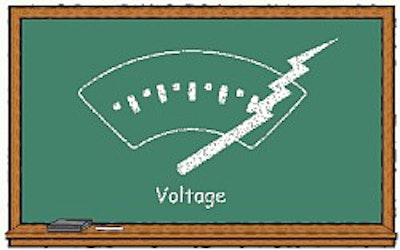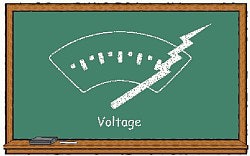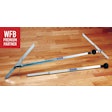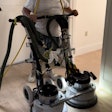

Electricity isn't something to mess around with on the job site. In fact, it deserves healthy respect — only 1 amp of electricity can stop your heart.
You can't avoid dealing with electricity while sanding, but you can take some precautions to make sure you're safe.
A first step is to make sure you have read and understood the manual and directions that came with your sanding equipment. With that said, here are a few more guidelines on how to make sanding a jolt-free job:
1) Be grounded
To start off, understand that the power for a big machine is an AC circuit, or alternating current. AC currents must have a ground to complete their circuit. For example, a big machine requires a 220 volt circuit, which has two legs that are 110 volts. Each of these legs is hot, and in order to complete the circuit, there must also be an earth ground that returns the electricity back to the source. In the process, the ground protects the machine and its operator from electric shock. Some states also require a GFCI, or ground fault circuit interrupter, which kills the circuit if there is a surge of electricity.
2) Be cable-compliant
Only the manufacturer's recommended type of cable should be used. For most North American sanding machines, that's a 10-3 cable (meaning it has three 10-gauge wires). Likewise, if you have to run extension cords, use an approved three-prong extension cord that has two connectors and an earth ground.
3) Don't burn out
Once you're ready to hook up the machine, use a voltage meter to check the voltage. This inexpensive device can save you hundreds or even thousands of dollars by making sure you have the correct voltage going into your machine. Most manufacturers recommend that voltage run between 208 and 240 volts. Running the sander with voltage that is too high or too low can burn out the motor and even set it on fire. If voltage is too low, use a booster box to get the voltage you need. If voltage is too high, the simplest solution is to run extra cable. Also pay attention that the voltage coming out of each 110 leg is the same. If they aren't, that also can burn out the switch or the motor.
4) Seize the power
Where to get this voltage. The most common source is the main electrical panel in the house. A circuit breaker must be used in line with the cable you are hooking up. Don't use alligator clips — that method is not approved by OSHA (Occupational Safety and Health Administration). If you open up the panel to hook up your power, cover it back up so that no one (such as children) can get their hands in there. After you remove your cord, plug in a knockout in that space.
If the panel is not accessible, or you don't have enough cable and booster boxes to make it useable, other sources for power include electric ranges, dryers and outdoor air conditioning units. Again, a circuit breaker must be used in line with your cable. When you are working on new construction, sometimes there will be a common pole off which all the contractors are getting their power. If you run your cable out there, make sure to flag it somehow so that vehicles don't run it over.
Wherever you are hooking up the power, if you see standing water, don't do it.
Some cities require that a licensed electrician do the power hookup. If that's the case, just do it — if you don't and the house burns down, your contractor's insurance most likely will not cover you.
5) Respect the cord
When you're using the big machine, buffer or edger, be wise about where you put the cord. Never put the cord around your neck. Horror stories — sadly true — abound about the tragic things that have happened to floor men because the cord was around their neck. A cord with a small nick in it on your sweaty neck can kill you. If the machine somehow goes out of control — down the stairs or off a second-story loft, for example — it will take you with it. One contractor escaped with only bruises when a truck ran over his cord (connected to a common pole outside), which became wrapped around the truck's wheel and dragged the sanding machine (still running and with the contractor attached) out the front door of the house.
Other common sense dealing with the cord includes being aware of where the cord is at all times, thus not running over it with the machine. Keep the cord in good condition, with no nicks, cuts, frayed ends or bad plugs. OSHA regulates how much tape can be on a certain length of cord, so find out what the regulations are and be compliant.
When you're off the job site, put your cords away. You don't want the children playing with them, nor do you want the home owner spilling a glass of water on them when he trips over your cord.
6) Don't be on the edge
Some contractors have particularly bad habits regarding their edgers. A common but bad practice is to cut off the ground on the plug. Others bypass the on/off switch when it burns out, thus being able to turn off the machine only by unplugging it. Both of these are exceptionally bad ideas.
A good habit is to lay the edger on its side every time you stop running it. That way, if you set it down to go flip the breaker back on, the edger won't start sanding on its own.
When you change the paper or make adjustments to the machine (including a big machine or buffer), make sure you unplug it in addition to turning it off. When you are unplugging, don't yank on the cord — take the extra five seconds to unplug it at the outlet.
7) Use protection
There are plenty of safety issues with sanding that have nothing to do with electricity, too, and it's just as important that you be aware of them.
Every time you're sanding, buffing or edging, you should protect your body by wearing a respirator, ear plugs or muffs and work boots. Be aware that some people's skin is highly reactive to wood dust, especially that of some exotic species such as wenge.
Remember the possibility of spontaneous combustion every time wood dust is present. Don't ever go to lunch or leave the job site for the day with bags of wood dust sitting there — they could begin to smolder and start afire. Likewise, don't leave those sanding bags in your van or in your shop.
Finally, when transporting your big machine, secure it in the van or truck. When you slam on the brakes, it makes for a very large projectile. Likewise, if you peel out of the driveway at mach speed, the machine can go flying right through the back doors.
Sanding a floor can be a dangerous business, but it doesn't have to be. If you follow these seven steps, you've got a good start on maintaining the health of both you and your business.

































